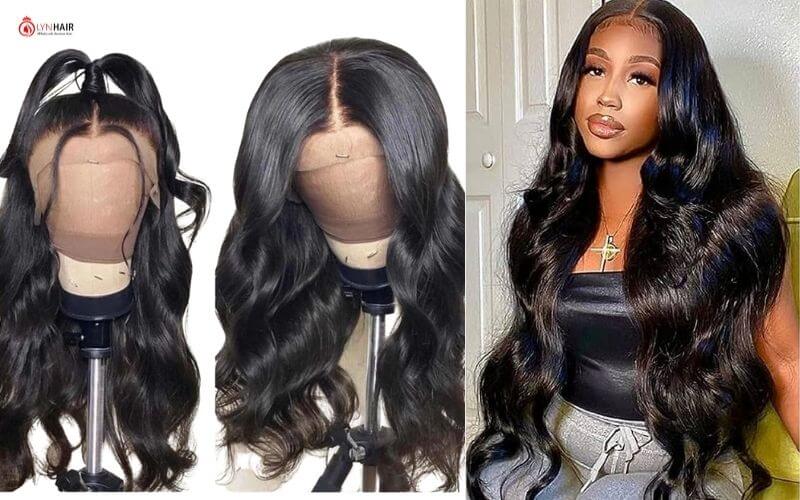Hey there, wig lovers! Ever wondered about the magic numbers – 150, 180, and 200 – when it comes to wig density? What’s its meaning and What’s different between 150 Density Wig VS 180 vs 200 ? This article is your guide to understanding these wig density options and helps you choose the perfect wig that matches your style and needs.
150 density wig overview

1. 150 density wig meaning
A 150 density wig refers to a type of wig that is made with a specific hair density. Hair density in wigs measures how many hair strands are packed into the wig per square inch. In the case of a 150 density wig, the wig is constructed with 150% more hair strands than the typical natural hair density. It is designed to be fuller and thicker in appearance compared to wigs with lower densities as 100%, 130 density wigs.
2. Is 150 Density Good For A Wig?
Yes, 150 density wigs offer an impressive amount of volume and create a full, luxurious look when worn. They are also well-suited for achieving various stylish hairstyles.
A 150 density is especially beneficial for individuals dealing with natural hair thinning, as they can provide a solution by offering a fuller head of hair through a wig.
However, it’s important to note that some individuals who prefer their wigs to closely mirror their natural hair may not favor 150 density wigs. They believe that these wigs can deviate from the natural appearance they desire in their wig.
3. How many bundles is 150 density wig?

A 150% density wig is indeed considered semi-full and thick, offering a lush appearance. When thinking about it in terms of bundles, a 16-inch 150% density wig is comparable to a frontal wig made with 2.5 bundles of hair. For a longer wig, such as 24, 26 inches, a 150% density wig is equivalent to a frontal wig made with 3.5 bundles of hair.
4. How much does a 150 density wig weigh?
The weight of a 150 density wig can vary depending on several factors, including the length and type of hair used, the construction of the wig cap, and any additional materials or accessories attached to the wig.
On average, a 150 density wig may weigh around 120 grams (3 ounces) to 300 grams (6 ounces) or even more for a human hair wig.
180 density wig overview

1. 180 density wig meaning
A 180 density wig is a type of wig known for its exceptionally high hair density. A 180 density wig stands out because it boasts a hair density of 180%, meaning there are 180% more hair strands meticulously arranged in the wig compared to the typical natural hair density. The result is a wig that appears incredibly full, thick, and voluminous.
2. Is 180 Density Good For A Wig?

If you’re looking for a dramatic and voluminous hairstyle, 180 density can be a great choice. It offers a bold and glamorous appearance, is versatile for various styling options, and is ideal for special occasions when you want to make a statement with your hair. However, some may prefer a more natural or lightweight look, while 180% density is considered a high hair density, it’s very thick and full.
3. How many bundles is 180 density wig?
A 180% density wig is equivalent to a frontal wig made with approximately 3.5 bundles when it’s a 14, 16-inch wig. For a longer wig, such as 24, 26 inches, a 180% density wig is equivalent to a frontal wig made with approximately 4.5 bundles of hair.
4. How many grams is 180 density wig
The weight of a 180 density wig can vary depending on several factors, including the length of the wig, the type of hair used, and the construction of the cap. However, to provide a general idea:
- A 180 density wig of shorter lengths, such as 12 to 16 inches, may weigh approximately 180 to 220 grams.
- For medium-length wigs, around 18 to 20 inches, the weight might range from 200 to 250 grams.
- Longer wigs, such as 22 to 24 inches, can weigh anywhere from 220 to 280 grams or more.
200 density wig overview

1. 200 density wig meaning
A 200% density wig indeed represents the maximum volume achievable, and it is often chosen for its bold and theatrical effect. While it comes in various lengths, it’s typically more practical for shorter hairstyles, as longer hair can become quite heavy for both the wearer and observers. These wigs are commonly seen on stage performers, particularly in Broadway productions, where dramatic and attention-grabbing looks are essential.
2. Is 200 Density Good For A Wig?
A 200 density wig can be a fantastic choice if you’re seeking an exceptionally bold and dramatic hairstyle. These wigs offer the highest level of volume and fullness, making them ideal for theatrical performances, cosplay, and occasions where making a dramatic statement is essential. However, if you prefer a more natural or subtle look, a 200 density wig might not be the best option, as it tends to appear noticeably fuller than most natural hair. Maintenance is also a consideration, as high-density wigs may require extra care to prevent tangling and retain their shape. .
3. How many bundles is 200 density wig
Creating a 200% density wig requires a significant amount of hair to achieve a full and voluminous look. The number of bundles needed depends on various factors, primarily the length of the wig, the texture of the hair, the wig cap size, and the desired level of fullness.
For shorter lengths, such as 10-14 inches, approximately 4.5 bundles of hair are typically required to achieve a 200% density. Medium-length wigs, ranging from 16-20 inches, may need around 5.5 bundles to reach the desired density. However, these are rough estimates, and individual variations can affect the number of bundles needed.
4. How many grams is 200 density wig

The weight of a 200% density wig varies depending on factors like hair length and texture. There’s no fixed weight in grams. Typically, for a 200% density wig, you’ll need double the hair compared to a 100% density wig. A standard hair bundle is around 3.5 to 4 ounces (100-113 grams). So, if you use four bundles weighing 3.5 ounces each, your wig would weigh approximately 14 ounces (400 grams).
Difference between 50 Density Wig VS 180 vs 200?
|
Aspect |
150% Density Wig |
180% Density Wig |
200% Density Wig |
|
Weight and Volume |
Moderate volume, providing a natural look. |
Offers more volume and thickness for added body. |
Maximum volume with substantial thickness. |
|
Hairstyle Options |
Suitable for various hairstyles, including straight, wavy, and curly. |
Ideal for achieving elaborate hairstyles, particularly if you desire extra body and bounce. |
Best for bold and dramatic styles, perfect for glamorous and eye-catching looks. |
|
Production Time |
Typically quicker to produce due to the lesser amount of hair required. |
May take a bit longer to produce compared to 150% density wigs due to the additional hair. |
Usually requires the most time to create due to the significant amount of hair and meticulous craftsmanship. |
|
Price Range |
Generally more affordable than higher-density options due to the lesser amount of hair used. |
Slightly more expensive than 150% density wigs due to the increased hair density. |
Typically the most expensive option due to the substantial amount of hair required and the time-intensive production process. |
150 density wig vs 180 vs 200 , Which One Is Best?

The choice between a 150%, 180%, or 200% density wig depends on your personal preferences and the look you want to achieve. There is no one-size-fits-all answer as each density level offers a different appearance and styling versatility. Here’s a breakdown to help you decide which one is best for you:
1. Face shape
If you want a natural look that suits most faces, go for 150% density. If you have a round or oval face and want more volume, 180% density can be flattering. If you want a bold and dramatic style, 200% density works for all face shapes.
2. Your natural hair density
Think about your natural hair. If it’s average thickness, 150% density can mimic it well. If your hair is thicker or you want a fuller look, choose 180%. For a dramatic change from your natural hair, go for 200%.
3. Texture of the wig
Consider the texture of the wig. 150% density suits various textures. 180% adds volume and works great for curly or wavy styles. 200% is best for bold and textured looks.
4. Budget
Keep your budget in mind. 150% density is usually the most affordable. 180% is a bit more expensive. 200% is the priciest due to more hair and craftsmanship.
5. Occasion
Think about when you’ll wear the wig. 150% density is for everyday or casual use. 180% is good for special occasions. 200% is for glamorous events or when you want to stand out.
How to Measure Wig Density at Home?
- Materials you will need:
A ruler or measuring tape: This will help you measure the wig cap in square inches or square centimeters.
A piece of white paper or a transparent plastic sheet: This will be used to create a visual guide for counting hair strands.

- Steps to Measure Wig Density:
Lay the wig flat: Place the wig on a clean, flat surface, such as a table or countertop. Ensure that the wig is spread out evenly and that the hair is not bunched up or tangled.
Create a reference area: Take your ruler or measuring tape and use it to create a reference area on the wig cap. This can be a square or rectangle of a specific size. For example, you might create a 1-inch by 1-inch square.
Count the hair strands: Place the piece of white paper or transparent plastic sheet over the reference area you created. This will make it easier to count the individual hair strands. Now, carefully count the number of hair strands within the reference area. Be as accurate as possible.
Calculate the density: Once you have counted the hair strands in the reference area, calculate the density by dividing the number of strands by the total area of the reference square. For example, if you counted 100 hair strands in a 1-inch by 1-inch square, the wig density would be 100%.
Repeat for accuracy: To get a more accurate measurement, you can repeat this process in different areas of the wig cap, especially if the wig has variations in density across different sections.
Average the measurements: If you measured the density in multiple areas, calculate the average density by adding up all the measurements and dividing by the number of measurements taken.
Keep in mind that wig density can vary throughout the wig, with some areas being denser than others. Measuring in multiple areas can give you a better overall understanding of the wig’s density.
𝑭𝒐𝒓 𝒎𝒐𝒓𝒆 𝒊𝒏𝒇𝒐𝒓𝒎𝒂𝒕𝒊𝒐𝒏, 𝒄𝒐𝒏𝒕𝒂𝒄𝒕:
Whatsapp: +84898890054
Follow us on Instagram: @ownhumanhairbusiness and @lynhair.factory
Website: hairbusiness.org

